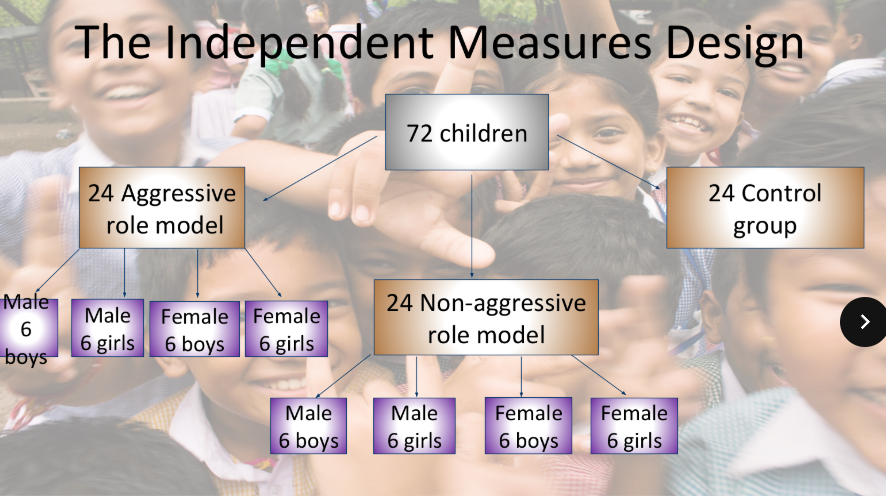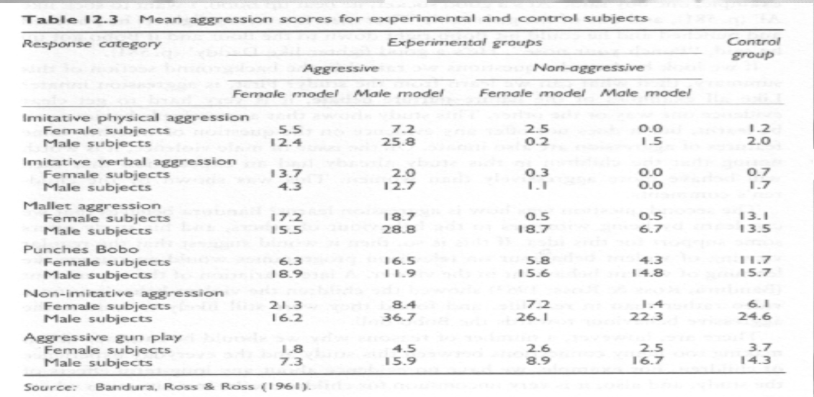Bandura et al. (1961) – “Transmission of aggression through imitation of aggressive models”
1/37
Earn XP
Description and Tags
Name | Mastery | Learn | Test | Matching | Spaced |
|---|
No study sessions yet.
38 Terms
Social Learning Theory (SLT)
We learn by observing others.
Our mental state is important in the learning process.
Learning doesn’t mean there will be a change in behavior.
Overall Aim
To investigate observational learning of aggression and show that observed behavior will be imitated.
Sub-Aim 1 (reproduction)
To see whether children would reproduce aggressive behaviour when the model was no longer present.
Sub-Aim 2 (sex)
To look for gender differences in the learning of aggression.
Sample Characteristics
72 Children
36 boys
36 girls
From Stanford University Nursery School
Ranged from 37-69 months (3-6 years old; M= 52 months)
Sampling Technique
Opportunity; wasn’t stated, however, but it can be assumed since the children were at Stanford (where the research took place) at the time.
Experimental Type
Laboratory Experiment
Research Method
Observations
Controlled
Non-participant
Covert
Time and Event Sampling.
Type of data collected
Quantitative AND Qualitative
Quantitative Data Collected
Consisted of response categories used by observers to record the number of times each behavior occurred while testing was taking place.
A record was made every 5 seconds over 20 minutes, thus, 240 instances were recorded throughout a session.
Qualitative Data Collected
Comments made by the children when observing the model.
“Who is that lady?”
“That’s not the way for ladies to behavior”
“That man is…. a good fighter, like daddy”
First IV (Type)
Type of role model
Non-aggressive model
Aggressive model
No model (control group)
Second IV (gender)
Sex of role model
Male role model
Female role model
Third IV (child)
Sex of children
Male
Female
DV 1 (IA)
Imitative aggression responses
Physical: any acts imitated, for example, striking Bobo with mallet, sitting on it, punching it in the nose, and throwing it in the air.
Verbal: phrases imitated, for example, “Pow” and “Sock him” and “Hit him down” and “Kick him” and “Throw him in the air”
DV 2 (PIR)
Partially imitative responses
Mallet aggression, using mallet on other toys
Sitting and/or bouncing on Bobo doll.
DV 3 (NIAR)
Non-imitative aggressive response
Slapping and/or punching the Bobo doll.
Non-imitative physical and verbal aggression.
Aggressive gun play.
DV 4 (Comments made)
Comments made the children:
Verbal comments included:
“Who is that lady?”“That’s not the way for ladies to behave.”
“That man is… a good fighter, like daddy.”
“Stupid ball”
“Horses fighting, biting”
“Knock over people”
Physical Imitative Aggression
Striking Bobo with mallet,
Sitting on the doll
Punching the doll in the nose,
Throwing the doll into the air.
Verbal imitative aggression
“Pow”
“Sock him”
“Hit him down”
“Kick him”
“Throw him in the air”
Mallet aggression
“Subject strikes objects other than the Bobo doll aggressively with the mallet”
Aggressive gun play
“Subject shoots darts or aims the guns and fire imaginary shots at objects in the room”
Experimental Design
Independent measures.
The experimental design also had an element of..
Matched Pairs
Because the children were matched for pre-existing levels of aggression by the experimenter and the nursery schoolteacher.
EX: A child who was rated as a 5 (very aggressive) was matched with a child who was also rated as 5 with one going into the aggressive group and one to the non-aggressive group.
Apparatus (Room 1)
Potato prints
Picture stickers
Table and Chair
Tinker toy set
Mallet
Inflatable 5-foot bobo doll (adult size)
Apparatus (Room 2)
Fire Engine
Locomotive
Doll set
Spinning top
Apparatus (Room 3)
One-way-mirror
3-foot bobo doll (child size)
Mallet
Peg board
Two dart guns
Tetherball with a face
Tea set
Three bears
Cars
Farm animals
Ball
Crayons and coloring paper
Independent Measures Design of Bandura

Controls
Toys in Room 3 were always the same and in the same position when a child entered the room.
The actions of the aggressive model were always the same, in the same order, and for the same length of time.
Observations were done by two independent observers. 20-minute session was divided into 5-second intervals, giving 240 recorded responses.
Rating of pre-existing aggression levels
Children in the experimental and control groups were, individually, pre-matched on their pre-existing levels of aggression. 51 subjects were rated by the nursery schoolteacher and the experimenter.
Each child was rated on four aspects using a 5-point scale.:
Physical aggression
Verbal aggression
Aggression towards inanimate objects
Aggressive inhibition
Room 1: Modeling; Aggressive Condition
Subjects were individually brought to the experimental room by the experimenter.
The experimenter instructed the child on using potato prints to design pictures.
After settling the child, the experimenter brought in a model and escorted them to the other end of the room.
The room contained a Tinker Toy set, a mallet, and an adult-sized Bobo doll.
The child observed the model assembling the Tinker Toy set for one minute.
The model then exhibited aggressive behavior towards the Bobo doll for the remaining nine minutes.
Aggressive actions included using a mallet to attack the doll and throwing it in the air while shouting "Pow, Boom."
Room 1: Modeling; Non-aggressive Condition
Subjects were individually brought to the experimental room by the experimenter.
The experimenter instructed the child on using potato prints to design pictures.
After settling the child, the experimenter brought in a model and escorted them to the other end of the room.
The room contained a Tinker Toy set, a mallet, and an adult-sized Bobo doll.
The child observed the model assembling the Tinker Toy set in a quiet and subdued manner and ignoring the bobo doll for all ten minutes.
Room 1: Modeling; Control Condition
Subjects were individually brought to the experimental room by the experimenter.
The experimenter instructed the child on using potato prints to design pictures.
After settling the child, the child was left alone in the room for ten minutes and was not exposed to any model at all.
Room 2: Aggression Arousal
At the end of the ten minutes in Room 1, the experimenter entered the room and informed the subject that we would now go to another game and bid the model (if there was one) goodbye
The child was brought to the second room that had attractive toys.
When the child started to play with the toys, usually within 2 minutes, the experimenter told the child these were the experimenter’s very best toys and she had decided to reserve them for the other children.
However, the subject could play with any of the toys in the next room.
All children (including the control group) were subjected to ‘mild aggression’. This was done to upset the child and create a deal of aggression at being took away from the toys that would carry to the next room.
Room 3: Test for Delayed Imitation
Experimental room contained aggressive toys and some non-aggressive toys.
A 3-foot bobo doll was present in the room.
The child was in the room for 20 minutes
Their behavior was observed and rated through a one-way mirror
Observations were made at 5-second intervals, therefore, giving 240 response units for each child
Other behaviors that didn’t imitate that of the model were also recorded (e.x aggressive gun play)
Mean aggression scores for experimental and control subjects (RESULTS)

Results (statements)
Children who observed the aggressive models made far more aggressive responses than the other two groups. This was found for all 3 measures (imitative, partial, and non-imitative aggression.
Boys showed more physical aggression while girls showed more verbal aggression
Boys were more likely to imitate same-sex models, but both sexes tended to imitate the same-sex models.
Conclusions
Witnessing aggression in a model can be enough to produce
aggression by an observer. If a behavior is observed, it can be
imitated.
Children selectively imitate gender-specific behaviors. They are
more likely to imitate a male model compared to the female
model, particularly with physical aggression.